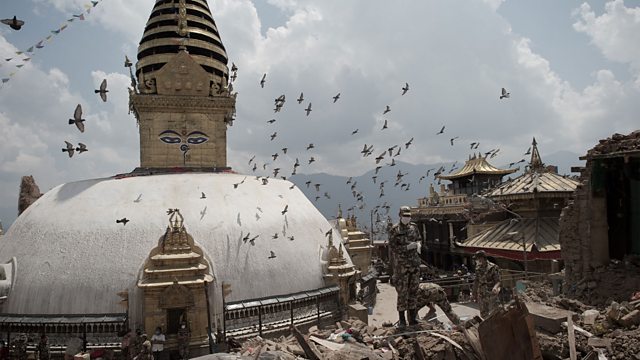
The Destructive Power of the Nepalese Earthquake
The destructive potential of earthquakes, how insects are solving crimes and revealing hidden histories, exploring the acoustics of icy waters, protecting the origins of stones.
Despite the recent 7.8 magnitude earthquake in Nepal having caused widespread destruction, video evidence of the shaking has shown that the tremors were significantly slower than would be expected. Seismologist Susan Hough from the US Geological Survey tells Roland Pease why the figures on the Moment Magnitude scale are not the only way to measure the extent of earthquake damage. Susan also explains how the earthquake has not been nearly as catastrophic as was feared.
Rebuilding Vanuatu with the Help of Smartphones
Click reports on the role that smartphones are playing in helping to rebuild Vanuatu following the devastation of Cyclone Pam? The data collected via smartphones is providing insights into the relative state of water, sanitation and hygiene systems across cyclone-damaged parts. Click hears from Stefan Kraus from Akvo about the open source software behind the project.
Authenticating Stone
For many food fans, and gastronomes, knowing which region a product comes from is key to assuring its quality and consistency. These needs have helped drive a global system of legal protection for products like Champagne wine and Parmesan cheese. Now, there are plans to authenticate and legally recognise regionally derived building stone. ����ý Science Correspondent Jonathan Amos reports on why knowing where your stone comes from can make a difference to building and business.
Invisibility
Have you ever wondered what it would be like to feel invisible? This is what neuroscientists at the Karolinska Institute in Stockholm have been investigating and they’ve succeeded – kind of. And it could one day have therapeutic potential.
Fighting Against Aids
Tony Fauci looks back at the scientific breakthroughs that have transformed HIV/Aids from a death sentence to a disease that can now be treated and prevented. Having watched in horror as his patients quickly died from the disease in the US in the early 1980s, as director of the National Institute of Allergy and Infectious Diseases, he has dedicated his career to fighting it.
Mistakes in Science
The history of science is littered with many ideas that we now know to be wrong. And of course some of the theories that are popular today will be forgotten in the future. Adam Rutherford asked three scientists, physicist Helen Czerski, cosmologist Andrew Pontzen and first biologist Tim Cockerill, about the biggest mistakes in their fields.
The Science Hour was presented by Claudia Hammond with comments from Jonathan Webb.
Producer: Deborah Cohen
(Photo: Nepalese soldiers clear the rubble of the damaged Swayambhunath temple in Kathmandu, following a 7.8 magnitude earthquake which struck the Himalayan nation on 25 April 2015 © Nicolas Asfouri/AFP/Getty Images)
Last on
More episodes
Previous
Next
Broadcasts
- Sat 9 May 2015 21:05GMT����ý World Service Online
- Sun 10 May 2015 10:05GMT����ý World Service Online
Podcast
-
![]()
Unexpected Elements
The news you know, the science you don't

